A Survey of Battery–Supercapacitor Hybrid Energy Storage Systems: Concept, Topology, Control and Application
Abstract
:1. Introduction
2. Classification and Characteristics of Hybrid Energy-Storage System
3. Key Technologies of Battery–Supercapacitor Hybrid Energy-Storage System
3.1. Energy Equalization Scheme of Energy-Storage Battery Pack
3.1.1. Dissipative Equalization Scheme
3.1.2. Non-Dissipative Equalization Scheme
Voltage-Difference-Based Type
Current-Direction-Based Type
Hybrid Type
3.2. Multi-Port Power Conversion System in BS-HESS
3.2.1. Non-Isolated Multi-Port Converter
3.2.2. Partially Isolated Multi-Port Converter
3.2.3. Fully Isolated Multi-Port Converter
3.2.4. Conclusions of Multi-Port Converters in BS-HESS
3.3. Energy Management System in BS-HESS
3.3.1. Rule-Based Energy Management Strategy
3.3.2. Optimization-Based Energy Management Strategy
3.3.3. Research Prospect
- (1)
- The rapid development of artificial intelligence has brought opportunities for energy management strategies of the BS-HESS. The optimization results obtained by big data can be learned through artificial intelligence algorithms, which can further improve the reliability of power distribution for the BS-HESS. Research on artificially intelligent power-distribution strategies is an important direction.
- (2)
- Currently, different power-distribution strategies for the BS-HESS are developed with a variety of characteristics. Integrating different power-distribution strategies can promote strengths and avoid weaknesses, which will be a promising research direction.
- (3)
- Numerous energy management strategies of the BS-HESS are highly dependent on the accuracy of parameters. Inaccurate parameters could result in a poor control effect. Improving the parameter robustness is the only way to realize the wide application of the BS-HESS.
3.4. Model Predictive Control Applied in Bidirectional Converters for BS-HESS
3.4.1. Finite Control Set MPC
3.4.2. Continuous Control Set MPC
3.4.3. Moving Discretized Control Set MPC
4. Applications of BS-HESS with Economic Feasibility Analysis
4.1. Applications of BS-HESS
4.1.1. Urban Rail Transit System
4.1.2. Electric Vehicles
4.1.3. Grid Energy Storage
- (1)
- Generation. The BS-HESS smooths out the intermittent characteristic of the renewable energy sources, thereby improving system stability. In addition, the BS-HESS stores the surplus renewable energy and releases it during periods of peak system demand, thereby increasing the utilization rate of renewable energy.
- (2)
- Transmission. The BS-HESS can integrate with HVDC and provide active and reactive power support. In addition, the BS-HESS can be installed in overloaded transmission nodes. Therefore, the BS-HESS avoids capital investment by delaying or deferring the upgrade of the existing transmission infrastructure.
- (3)
- Distribution. One of the main functions of the BS-HESS is balancing the power supply and demand. Furthermore, grid black start can be realized by the BS-HESS.
- (4)
- Use. Users can profit by charging the BS-HESS when energy demand is low and selling the stored energy when the demand is high. Additionally, the BS-HESS can serve as an urgent power supply for critical equipment.
4.2. Applications of BS-HESS
5. Conclusions
Author Contributions
Funding
Data Availability Statement
Acknowledgments
Conflicts of Interest
References
- Qiao, L.; Zhang, X.; Sun, X.; Zhang, X.; Ma, Y. Advances in Battery-Supercapacitor Hybrid Energy Storage System. Energy Stor. Sci. Technol. 2022, 11, 98–106. [Google Scholar]
- Sun, J.; Li, M.; Zhang, Z.; Xu, T.; He, J.; Wang, H.; Li, G. Renewable energy transmission by HVDC across the continent: System challenges and opportunities. CSEE J. Power Energy Syst. 2017, 3, 353–364. [Google Scholar] [CrossRef]
- Chen, H.; Jin, J.; Chen, J. Catching up in new energy vehicle industry: Review of its development and policies in China. In Proceedings of the IEEE International Conference on Management of Innovation and Technology, Bangkok, Thailand, 21–24 September 2008. [Google Scholar]
- Li, X.; Ma, R.; Wang, L.; Wang, S.; Hui, D. Energy Management Strategy for Hybrid Energy Storage Systems with Echelon-use Power Battery. In Proceedings of the IEEE International Conference on Applied Superconductivity and Electromagnetic Devices (ASEMD), Tianjin, China, 16–18 October 2020. [Google Scholar]
- Obukhov, S.G.; Plotnikov, I.A.; Masolov, V.G. The effective energy storage for hybrid power systems with renewable energy sources. In Proceedings of the International Conference on Electrotechnical Complexes and Systems (ICOECS), Ufa, Russia, 21–25 October 2019. [Google Scholar]
- Andreev, M.K. An Overview of Supercapacitors as New Power Sources in Hybrid Energy Storage Systems for Electric Vehicles. In Proceedings of the National Conference with International Participation (ELECTRONICA), Sofia, Bulgaria, 23–24 July 2020. [Google Scholar]
- Zhang, H.; Dou, H.; Ren, J.; Li, J.; Zhang, H. Research on the application of superconducting magnetic energy storage in wind/photovoltaic generation system. In Proceedings of the International Conference on Power Electronics and Drive Systems (PEDS), Taipei, Taiwan, 2–5 November 2009. [Google Scholar]
- Li, X.; Wang, S. Energy management and operational control methods for grid battery energy storage systems. CSEE J. Power Energy Syst. 2021, 7, 1026–1040. [Google Scholar]
- Sun, B.; Tian, S.; He, J.; Liu, L.; Wang, Z.; Guo, J.; Xu, F.; Cheng, T.; Li, J. Review on Pumped Storage Power Station in High Proportion Renewable Energy Power System. In Proceedings of the IEEE 3rd Student Conference on Electrical Machines and Systems (SCEMS), Jinan, China, 4–6 December 2020. [Google Scholar]
- Srikanth, K.; Mahesh, K.M. Energy management of hybrid microgrid with hybrid energy storage system. In Proceedings of the International Conference on Renewable Energy Research and Applications (ICRERA), Palermo, Italy, 22–25 November 2015. [Google Scholar]
- Ning, Y.; Bo, Z.; Wei, L.; Shaohua, M. Hybrid Energy Storage Capacity Allocation Method for Active Distribution Network Considering Demand Side Response. IEEE Trans. Appl. Supercond. 2019, 29, 1–4. [Google Scholar]
- Dong-Jing, L.; Wang, L. Small-Signal Stability Analysis of an Autonomous Hybrid Renewable Energy Power Generation/Energy Storage System Part I: Time-Domain Simulations. IEEE Trans. Energy Convers. 2008, 23, 311–320. [Google Scholar]
- Zhang, Y.; Jiang, Z. Dynamic Power Sharing Strategy for Active Hybrid Energy Storage Systems. In Proceedings of the IEEE Vehicle Power and Propulsion Conference, Dearborn, MI, USA, 7–10 September 2009. [Google Scholar]
- Zhu, Y.; Yin, Z.; Tian, J. Microgrids Based on DC Energy Pool. In Proceedings of the IEEE Energy 2030 Conference, Atlanta, GA, USA, 17–18 November 2008. [Google Scholar]
- Jun, C.; Wang, P.; Lalit, G.; Xu, Y. A Two-Layer Energy Management System for Microgrids with Hybrid Energy Storage Considering Degradation Costs. IEEE Trans. Smart Grid 2018, 9, 6047–6057. [Google Scholar]
- Graber, G.; Galdi, V.; Calderaro, V.; Piccolo, A. Sizing and energy management of on-board hybrid energy storage systems in urban rail transit. In Proceedings of the International Conference on Electrical Systems for Aircraft, Railway, Ship Propulsion and Road Vehicles & International Transportation Electrification Conference (ESARS-ITEC), Toulouse, France, 2–4 November 2016. [Google Scholar]
- Kong, D.; Miyatake, M. Energy Management of Superconducting Magnetic Energy Storage Applied to Urban Rail Transit for Regenerative Energy Recovery. In Proceedings of the International Conference on Electrical Machines and Systems (ICEMS), Hamamatsu, Japan, 24–27 November 2020. [Google Scholar]
- Kollmeyer, P.; Wootton, M.; Reimers, J.; Stiene, T.; Chemali, E.; Wood, M.; Emadi, A. Optimal performance of a full scale li-ion battery and li-ion capacitor hybrid energy storage system for a plug-in hybrid vehicle. In Proceedings of the IEEE Energy Conversion Congress and Exposition (ECCE), Cincinnati, OH, USA, 1–5 October 2017. [Google Scholar]
- Zhang, Y.; Yu, Y.; Zhang, B.; Zhao, J.; Xu, W.; Zhou, Q. Overview of The Current Situation and Development of Lead-acid Battery. Chin. LABAT Man. 2021, 58, 27–31. [Google Scholar]
- Mamen, A.; Supatti, U. A survey of hybrid energy storage systems applied for intermittent renewable energy systems. In Proceedings of the International Conference on Electrical Engineering/Electronics, Computer, Telecommunications and In-formation Technology (ECTI-CON), Phuket, Thailand, 27–30 June 2017. [Google Scholar]
- Wang, L.; He, X.; Gao, J.; Li, J.; Jiang, C. Manufacturing method for cathode materials of Li-ion batteries. Energy Stor. Sci. Technol. 2018, 7, 888–896. [Google Scholar]
- Rong, X.; Lu, Y.; Qi, X.; Zhou, Q.; Kong, W.; Tang, K.; Chen, L.; Hu, Y. Na-ion batteries: From fundamental research to engineering exploration. Energy Stor. Sci. Technol. 2020, 9, 515–522. [Google Scholar]
- Inoue, M.; Tsuzuki, Y.; Iizuka, Y.; Shimada, M. Carbon Fiber Electrode for Redox Flow Battery. J. Electrochem. Soc. 2019, 134, 756. [Google Scholar] [CrossRef]
- Soltani, M.; Jaguemont, J.; Van Mierlo, J.; Van den Bossche, P. Determination of cycling frequency with the highest impact on lifetime of Super Capacitor. In Proceedings of the IEEE Electrical Power and Energy Conference (EPEC), Montreal, QC, Canada, 16–18 October 2019. [Google Scholar]
- Ronsmans, J.; Lalande, B. Combining energy with power: Lithium-Ion Capacitors. In Proceedings of the International Symposium on Power Electronics, Electrical Drives, Automation and Motion (SPEEDAM), Capri, Italy, 22–24 June 2016. [Google Scholar]
- Gomez, J.; Perez, B.; Suarez, P.; Alvarez, A.; Rivera, B. Theoretical and Experimental Studies of SMES Configurations for Design Optimization. IEEE Trans. Appl. Supercond. 2021, 31, 1–5. [Google Scholar] [CrossRef]
- Gnanavel, C.; Muruganantham, P.; Vanchinathan, K.; Johny Renoald, A. Experimental Validation and Integration of Solar PV Fed Modular Multilevel Inverter (MMI) and Flywheel Storage System. In Proceedings of the IEEE Mysore Sub Section International Conference (MysuruCon), Hassan, India, 24–25 October 2021. [Google Scholar]
- Mohamed, M.G.; Mansoure, T.H.; Samy, M.M.; Takashi, Y.; Mohammed, A.A.K.; Ahamad, T.; Alshehri, S.M.; Kim, J.; Matsagar, B.M.; Wu, K.C.W.; et al. Ultrastable Conjugated Microporous Polymers Containing Benzobisthiadiazole and Pyrene Building Blocks for Energy Storage Applications. Molecules 2022, 27, 2025. [Google Scholar] [CrossRef] [PubMed]
- Jian, C.; Nigel, S.; Ali, E. Battery balancing methods: A comprehensive review. In Proceedings of the IEEE Vehicle Power and Propulsion Conference, Harbin, China, 3–5 September 2008. [Google Scholar]
- Daowd, M.; Omar, N.; Van den Bossche, P.; Van Mierlo, J. A review of passive and active battery balancing based on MATLAB/Simulink. Int. Rev. Electr. Eng. 2011, 6, 2974–2989. [Google Scholar]
- Isaacson, M.J.; Hollandsworth, R.P.; Giampaoli, P.J.; Linkowsky, F.A.; Salim, A.; Teofilo, V.L. Advanced lithium ion battery charger. In Proceedings of the Annual Battery Conference on Applications and Advances (Cat. No.00TH8490), Long Beach, CA, USA, 11–14 January 2000. [Google Scholar]
- Xu, J.; Mei, X.S.; Wang, J.P. A High Power Low-Cost Balancing System for Battery Strings. Energy Procedia 2019, 158, 2948–2953. [Google Scholar] [CrossRef]
- Gallardo-Lozano, J.; Romero-Cadaval, E.; Milanes-Montero, M.I.; Guerrero-Martinez, M.A. Battery equalization active methods. J. Power Sources 2014, 246, 934–949. [Google Scholar] [CrossRef]
- Daowd, M.; Antoine, M.; Omar, N.; van den Bossche, P.; van Mierlo, J. Single Switched Capacitor Battery Balancing System Enhancements. Energies 2013, 6, 2149–2174. [Google Scholar] [CrossRef] [Green Version]
- Pascual, C.; Krein, P.T. Switched capacitor system for automatic series battery equalization. In Proceedings of the APEC 97—Applied Power Electronics Conference, Atlanta, GA, USA, 23–27 February 1997. [Google Scholar]
- Kim, M.Y.; Kim, C.H.; Kim, J.H.; Moon, G.W. A Chain Structure of Switched Capacitor for Improved Cell Balancing Speed of Lithium-Ion Batteries. IEEE Trans. Ind. Electron. 2014, 61, 3989–3999. [Google Scholar] [CrossRef]
- Baughman, A.; Ferdowsi, M. Double-Tiered Capacitive Shuttling Method for Balancing Series-Connected Batteries. In Proceedings of the 2005 IEEE Vehicle Power and Propulsion Conference, Chicago, IL, USA, 7 September 2005. [Google Scholar]
- Du, J.; Wang, Y.; Tripathi, A.; Lam, J.S.L. Li-Ion Battery Cell Equalization by Modules with Chain Structure Switched Capacitors. In Proceedings of the 2016 Asian Conference on Energy, Power and Transportation Electrification (ACEPT), Singapore, 25–27 October 2016. [Google Scholar]
- Ye, Y.; Cheng, K.W.E.; Fong, Y.C.; Xue, X.; Lin, J. Topology, Modeling, and Design of Switched-Capacitor-Based Cell Balancing Systems and Their Balancing Exploration. IEEE Trans. Power Electron. 2017, 32, 4444–4454. [Google Scholar] [CrossRef]
- Shang, Y.; Lu, F.; Xia, B.; Zhang, C.; Cui, N.; Mi, C. A Switched-Coupling-Capacitor Equalizer for Series-Connected Battery Strings. In Proceedings of the 2017 IEEE Applied Power Electronics Conference and Exposition (APEC), Tampa, FL, USA, 26–30 March 2017. [Google Scholar]
- Shang, Y.; Zhang, C.; Cui, N.; Mi, C.C. A Delta-Structured Switched-Capacitor Equalizer for Series-Connected Battery Strings. IEEE Trans. Power Electron. 2019, 34, 452–461. [Google Scholar]
- Shang, Y.; Cui, N.; Duan, B.; Zhang, C. Analysis and Optimization of Star-Structured Switched-Capacitor Equalizers for Series-Connected Battery Strings. IEEE Trans. Power Electron. 2018, 33, 9631–9646. [Google Scholar] [CrossRef]
- Shang, Y.; Zhang, Q.; Cui, N.; Duan, B.; Zhang, C. An Optimized Mesh-Structured Switched-Capacitor Equalizer for Lithium-Ion Battery Strings. IEEE Trans. Transp. Electrif. 2019, 5, 252–261. [Google Scholar] [CrossRef]
- Yuanmao, Y.; Cheng, K.W.E.; Yeung, Y.P.B. Zero-Current Switching Switched-Capacitor Zero-Voltage-Gap Automatic Equalization System for Series Battery String. IEEE Trans. Power Electron. 2012, 27, 3234–3242. [Google Scholar] [CrossRef]
- Li, S.; Mi, C.C.; Zhang, M. A High-Efficiency Active Battery-Balancing Circuit Using Multiwinding Transformer. IEEE Trans. Ind. Appl. 2013, 49, 198–207. [Google Scholar] [CrossRef]
- Shang, Y.; Xia, B.; Zhang, C.; Cui, N.; Yang, J.; Mi, C.C. An Automatic Equalizer Based on Forward–Flyback Converter for Series-Connected Battery Strings. IEEE Trans. Ind. Electron. 2017, 64, 5380–5391. [Google Scholar] [CrossRef]
- Vardhan, R.K.; Selvathai, T.; Reginald, R.; Sivakumar, P.; Sundaresh, S. Modeling of Single Inductor Based Battery Balancing Circuit for Hybrid Electric Vehicles. In Proceedings of the IECON 2017—43rd Annual Conference of the IEEE Industrial Electronics Society, Beijing, China, 29 October–1 November 2017. [Google Scholar]
- Zheng, X.; Liu, X.; He, Y.; Zeng, G. Active Vehicle Battery Equalization Scheme in the Condition of Constant-Voltage/Current Charging and Discharging. IEEE Trans. Veh. Technol. 2017, 66, 3714–3723. [Google Scholar]
- Hsieh, Y.C.; Moo, C.S.; Tsai, I.S.; Cheng, J.C. Dynamic Charge Equalization for Series-Connected Batteries. In Proceedings of the 2002 IEEE International Conference on Industrial Technology, 2002 IEEE ICIT ’02, Bankok, Thailand, 11–14 December 2002. [Google Scholar]
- Phung, T.H.; Collet, A.; Crebier, J.-C. An Optimized Topology for Next-to-Next Balancing of Series-Connected Lithium-Ion Cells. IEEE Trans. Power Electron. 2014, 29, 4603–4613. [Google Scholar] [CrossRef]
- Lim, C.-S.; Lee, K.-J.; Ku, N.-J.; Hyun, D.-S.; Kim, R.-Y. A Modularized Equalization Method Based on Magnetizing Energy for a Series-Connected Lithium-Ion Battery String. IEEE Trans. Power Electron. 2014, 29, 1791–1799. [Google Scholar] [CrossRef]
- Shang, Y.; Cui, N.; Zhang, C. An Optimized Any-Cell-to-Any-Cell Equalizer Based on Coupled Half-Bridge Converters for Series-Connected Battery Strings. IEEE Trans. Power Electron. 2019, 34, 8831–8841. [Google Scholar] [CrossRef]
- Chen, Y.; Liu, X.; Cui, Y.; Zou, J.; Yang, S. A MultiWinding Transformer Cell-to-Cell Active Equalization Method for Lithium-Ion Batteries With Reduced Number of Driving Circuits. IEEE Trans. Power Electron. 2016, 31, 4916–4929. [Google Scholar]
- Moo, C.S.; Hsieh, Y.C.; Tsai, I.S. Charge Equalization for Series-Connected Batteries. IEEE Trans. Aerosp. Electron. Syst. 2003, 39, 704–710. [Google Scholar] [CrossRef]
- Lu, X.; Qian, W.; Peng, F.Z. Modularized Buck-Boost + Cuk Converter for High Voltage Series Connected Battery Cells. In Proceedings of the 2012 Twenty-Seventh Annual IEEE Applied Power Electronics Conference and Exposition (APEC), Orlando, FL, USA, 5–9 February 2012. [Google Scholar]
- Wang, Z.; Luo, Q.; Wei, Y.; Mou, D.; Lu, X.; Sun, P. Topology Analysis and Review of Three-Port DC–DC Converters. IEEE Trans. Power Electron. 2020, 35, 11783–11800. [Google Scholar] [CrossRef]
- Wu, H.; Sun, K.; Ding, S.; Xing, Y. Topology Derivation of Nonisolated Three-Port DC–DC Converters From DIC and DOC. IEEE Trans. Power Electron. 2013, 28, 3297–3307. [Google Scholar] [CrossRef]
- Faraji, R.; Ding, L.; Esteki, M.; Mazloum, N.; Khajehoddin, S.A. Soft-Switched Single Inductor Single Stage Multiport Bidirectional Power Converter for Hybrid Energy Systems. IEEE Trans. Power Electron. 2021, 36, 11298–11315. [Google Scholar] [CrossRef]
- Solero, L.; Lidozzi, A.; Pomilio, J.A. Design of Multiple-Input Power Converter for Hybrid Vehicles. IEEE Trans. Power Electron. 2005, 20, 1007–1016. [Google Scholar] [CrossRef]
- Jibhkate, S.; Biswas, I.; Kastha, D.; Bajpai, P. Three Port DC-DC Converter for Storage Integration in Microgrid. In Proceedings of the 2016 National Power Systems Conference (NPSC), Bhubaneswar, India, 19–21 December 2016. [Google Scholar]
- Askarian, I.; Pahlevani, M.; Knight, A.M. Three-Port Bidirectional DC/DC Converter for DC Nanogrids. IEEE Trans. Power Electron. 2021, 36, 8000–8011. [Google Scholar] [CrossRef]
- Su, G.-J.; Peng, F.Z. A Low Cost, Triple-Voltage Bus DC-DC Converter for Automotive Applications. In Proceedings of the Twentieth Annual IEEE Applied Power Electronics Conference and Exposition, 2005. APEC 2005, Austin, TX, USA, 6–10 March 2005. [Google Scholar]
- Ding, Z.; Yang, C.; Zhang, Z.; Wang, C.; Xie, S. A Novel Soft-Switching Multiport Bidirectional DC–DC Converter for Hybrid Energy Storage System. IEEE Trans. Power Electron. 2014, 29, 1595–1609. [Google Scholar] [CrossRef]
- Zhao, C.; Round, S.D.; Kolar, J.W. An Isolated Three-Port Bidirectional DC-DC Converter with Decoupled Power Flow Management. IEEE Trans. Power Electron. 2008, 23, 2443–2453. [Google Scholar] [CrossRef]
- Biswas, I.; Kastha, D.; Bajpai, P. Small Signal Modeling and Decoupled Controller Design for a Triple Active Bridge Multiport DC–DC Converter. IEEE Trans. Power Electron. 2021, 36, 1856–1869. [Google Scholar] [CrossRef]
- Jakka, V.N.S.R.; Shukla, A.; Demetriades, G.D. Dual-Transformer-Based Asymmetrical Triple-Port Active Bridge (DT-ATAB) Isolated DC–DC Converter. IEEE Trans. Ind. Electron. 2017, 64, 4549–4560. [Google Scholar] [CrossRef]
- Chen, H.; Xiong, R.; Lin, C.; Shen, W. Model Predictive Control Based Real-Time Energy Management for Hybrid Energy Storage System. CSEE J. Power Energy Syst. 2021, 7, 862–874. [Google Scholar]
- Wang, B.; Xu, J.; Cao, B.; Ning, B. Adaptive Mode Switch Strategy Based on Simulated Annealing Optimization of a Multi-Mode Hybrid Energy Storage System for Electric Vehicles. Appl. Energy 2017, 194, 596–608. [Google Scholar] [CrossRef]
- Feng, X.; Gooi, H.B.; Chen, S.X. Hybrid Energy Storage with Multimode Fuzzy Power Allocator for PV Systems. IEEE Trans. Sustain. Energy 2014, 5, 389–397. [Google Scholar] [CrossRef]
- Zhao, Y.; Xia, H.; Wang, J.; Yang, Z.; Lin, F. Control Strategy of Ultracapacitor Storage System in Urban Mass Transit System Based on Dynamic Voltage Threshold. Trans. China Electrotech. Soc. 2015, 30, 427–433. [Google Scholar]
- Chen, Y.; Lin, Y.; Wang, S.; Zhou, J. Optimal Control Strategy of Hybrid Energy Storage Based on Filter Allocation Method. Trans. China Electrotech. Soc. 2020, 35, 4009–4018. [Google Scholar]
- Hredzak, B.; Agelidis, V.G.; Jang, M. A Model Predictive Control System for a Hybrid Battery-Ultracapacitor Power Source. IEEE Trans. Power Electron. 2014, 29, 1469–1479. [Google Scholar] [CrossRef]
- Amin; Bambang, R.T.; Rohman, A.S.; Dronkers, C.J.; Ortega, R.; Sasongko, A. Energy Management of Fuel Cell/Battery/Supercapacitor Hybrid Power Sources Using Model Predictive Control. IEEE Trans. Ind. Inform. 2014, 10, 1992–2002. [Google Scholar] [CrossRef]
- Wang, Y.; Yang, Z.; Lin, F.; An, X.; Zhou, H.; Fang, X. A Hybrid Energy Management Strategy based on Line Prediction and Condition Analysis for the Hybrid Energy Storage System of Tram. IEEE Trans. Ind. Appl. 2020, 56, 1793–1803. [Google Scholar] [CrossRef]
- Shen, J.; Khaligh, A. A Supervisory Energy Management Control Strategy in a Battery/Ultracapacitor Hybrid Energy Storage System. IEEE Trans. Transp. Electrif. 2015, 1, 223–231. [Google Scholar] [CrossRef]
- Cortes, P.; Kazmierkowski, M.P.; Kennel, R.M.; Quevedo, D.E.; Rodriguez, J. Predictive Control in Power Electronics and Drives. IEEE Trans. Ind. Electron. 2008, 55, 4312–4324. [Google Scholar] [CrossRef]
- Akter, P.; Uddin, M.; Mekhilef, S.; Tan, N.M.L.; Akagi, H. Model predictive control of bidirectional isolated DC-DC converter for energy conversion system. Int. J. Electron. 2015, 102, 1407–1427. [Google Scholar] [CrossRef] [Green Version]
- An, F.; Song, W.; Yang, K.; Hou, N.; Ma, J. Improved dynamic performance of dual active bridge dc–dc converters using MPC scheme. IET Power Electron. 2018, 11, 1756–1765. [Google Scholar] [CrossRef]
- An, F.; Yang, K.; Wang, S.; Luo, S.; Feng, X. Current stress optimized scheme with model-based feedforward for dual-active-bridge DC-DC converters. Trans. China Electrotech. Soc. 2018, 34, 2946–2956. [Google Scholar]
- Li, X.; Dong, Z.; Han, M.; Li, Z.; Zhang, Z. Turn-off Switching Loss Optimization Strategy with Model Predictive Control for Dual-Active-Bridge Converters. In Proceedings of the 2021 IEEE International Conference on Predictive Control of Electrical Drives and Power Electronics (PRECEDE), Jinan, China, 20–22 November 2021. [Google Scholar]
- Han, M.; Zhang, Z.; Dong, Z.; Li, X.; Li, Z. Output Bias-Free Predictive Control of Dual Active Bridge Converters in Fuel Cell Vehicles. In Proceedings of the IEEE 12th Energy Conversion Congress & Exposition—Asia, Singapore, 24–27 May 2021. [Google Scholar]
- An, F.; Song, W.; Yu, B.; Yang, K. Model Predictive Control With Power Self-Balancing of the Output Parallel DAB DC–DC Converters in Power Electronic Traction Transformer. IEEE Trans. Emerg. Sel. Top. Power Electron. 2018, 6, 1806–1818. [Google Scholar] [CrossRef]
- Zhang, H.; Li, Y.; Li, Z.; Zhao, C.; Gao, F.; Hu, Y.; Luo, L.; Luan, K.; Wang, P. Model predictive control of input-series output-parallel dual active bridge converters based DC transformer. IET Power Electron. 2020, 13, 1144–1152. [Google Scholar] [CrossRef]
- Chen, L.; Shao, S.; Xiao, Q.; Tarisciotti, L.; Wheeler, P.W.; Dragicevic, T. Model Predictive Control for Dual-Active-Bridge Converters Supplying Pulsed Power Loads in Naval DC Micro-Grids. IEEE Trans. Power Electron. 2020, 35, 1957–1966. [Google Scholar] [CrossRef]
- Xiao, Q.; Chen, L.; Jia, H.; Wheeler, P.W.; Dragicevic, T. Model Predictive Control for Dual Active Bridge in Naval DC Microgrids Supplying Pulsed Power Loads Featuring Fast Transition and Online Transformer Current Minimization. IEEE Trans. Ind. Electron. 2020, 67, 5197–5203. [Google Scholar] [CrossRef]
- Chen, L.; Lin, L.; Shao, S.; Gao, F.; Wang, Z.; Wheeler, P.W.; Dragicevic, T. Moving Discretized Control Set Model-Predictive Control for Dual-Active Bridge With the Triple-Phase Shift. IEEE Trans. Power Electron. 2020, 35, 8624–8637. [Google Scholar] [CrossRef]
- Chen, L.; Gao, F.; Shen, K.; Wang, Z.; Tarisciotti, L.; Wheeler, P.; Dragicevic, T. Predictive Control Based DC Microgrid Stabilization With the Dual Active Bridge Converter. IEEE Trans. Ind. Electron. 2020, 67, 8944–8956. [Google Scholar] [CrossRef]
- Tarisciotti, L.; Chen, L.; Shao, S.; Dragicevic, T.; Wheeler, P.; Zanchetta, P. Finite Control Set Model Predictive Control for Dual Active Bridge converter. IEEE Trans. Ind. Appl. 2021, 58, 2155–2165. [Google Scholar] [CrossRef]
- Byrne, R.H.; Nguyen, T.A.; Copp, D.A.; Chalamala, B.R.; Gyuk, I. Energy Management and Optimization Methods for Grid Energy Storage Systems. IEEE Access 2017, 6, 13231–13260. [Google Scholar] [CrossRef]
- Liu, R.; Xu, L.; Liu, F.; Zheng, Z.; Wang, K.; Li, Y. A Novel Architecture of Urban Rail Transit Based on Hybrid Energy Storage Systems Using Droop Control. In Proceedings of the IEEE International Conference on Electrical Systems for Aircraft, Railway, Ship Propulsion and Road Vehicles and International Transportation Electrification Conference, Nottingham, UK, 7–9 November 2018. [Google Scholar]
- Zhu, F.; Yang, Z.; Zhao, Z.; Lin, F. Two-Stage Synthetic Optimization of Supercapacitor-Based Energy Storage Systems, Traction Power Parameters and Train Operation in Urban Rail Transit. IEEE Trans. Veh. Technol. 2021, 70, 8590–8605. [Google Scholar] [CrossRef]
- Liu, Y.; Yang, Z.; Wu, X.; Lan, L.; Lin, F.; Su, H.; Huang, J. Adaptive Threshold Adjustment Strategy Based on Fuzzy Logic Control for Ground Energy Storage System in Urban Rail Transit. IEEE Trans. Veh. Technol. 2021, 70, 9945–9956. [Google Scholar] [CrossRef]
- Yang, Z.; Zhu, F.; Lin, F. Deep-Reinforcement-Learning-Based Energy Management Strategy for Supercapacitor Energy Storage Systems in Urban Rail Transit. IEEE Trans. Intell. Transp. Syst. 2021, 22, 1150–1160. [Google Scholar] [CrossRef]
- Liu, Y.; Yang, Z.; Lin, F.; Fang, X.; Sun, H. Study on Adaptive Energy Management and Optimal Capacity Configuration of Urban Rail Ground Hybrid Energy Storage System. Trans. China Electrotech. Soc. 2021, 36, 4874–4884. [Google Scholar]
- Williamson, S.S.; Rathore, A.K.; Musavi, F. Industrial Electronics for Electric Transportation: Current State-of-the-Art and Future Challenges. IEEE Trans. Ind. Electron. 2015, 62, 3021–3032. [Google Scholar] [CrossRef]
- Naseri, F.; Farjah, E.; Ghanbari, T. An efficient regenerative braking system based on battery/supercapacitor for electric, hybrid, and plug-in hybrid electric vehicles with BLDC motor. IEEE Trans. Veh. Technol. 2017, 66, 3724–3738. [Google Scholar] [CrossRef]
- Chemali, E.; Preindl, M.; Malysz, P.; Emadi, A. Electrochemical and Electrostatic Energy Storage and Management Systems for Electric Drive Vehicles: State-of-the-Art Review and Future Trends. IEEE Trans. Emerg. Sel. Top. Power Electron. 2016, 4, 1117–1134. [Google Scholar] [CrossRef]
- Merabet, A.; Tawfique Ahmed, K.; Ibrahim, H.; Beguenane, R.; Ghias, A.M.Y.M. Energy Management and Control System for Laboratory Scale Microgrid Based Wind-PV-Battery. IEEE Trans. Sustain. Energy 2017, 8, 145–154. [Google Scholar] [CrossRef]
- Sedghi, M.; Ahmadian, A.; Aliakbar-Golkar, M. Optimal storage planning in active distribution network considering uncertainty of wind power distributed generation. IEEE Trans. Power Syst. 2016, 31, 304–316. [Google Scholar] [CrossRef]
- Stroe, D.I.; Knap, V.; Swierczynski, M.; Stroe, A.I.; Teodorescu, R. Operation of a grid-connected lithium-ion battery energy storage system for primary frequency regulation: A battery lifetime perspective. IEEE Trans. Ind. Appl. 2017, 53, 430–438. [Google Scholar] [CrossRef]
- Jiang, Q.; Hong, H. Wavelet-based capacity configuration and coordinated control of hybrid energy storage system for smoothing out wind power fluctuations. IEEE Trans. Power Syst. 2013, 28, 1363–1372. [Google Scholar] [CrossRef]
- Tummuru, N.R.; Mishra, M.K.; Srinivas, S. Dynamic energy management of hybrid energy storage system with high-gain PV converter. IEEE Trans. Energy Convers. 2015, 30, 150–160. [Google Scholar] [CrossRef]
- Oriti, G.; Julian, A.L.; Anglani, N.; Hernandez, G.D. Novel Economic Analysis to Design the Energy Storage Control System of a Remote Islanded Microgrid. IEEE Trans. Ind. Appl. 2018, 54, 6332–6342. [Google Scholar] [CrossRef]
- Murty, V.V.; Kumar, A. Optimal energy management and techno-economic analysis in microgrid with hybrid renewable energy sources. J. Mod. Power Syst. Clean Energy 2020, 8, 929–940. [Google Scholar] [CrossRef]
- Roy, P.; He, J.; Liao, Y. Cost Minimization of Battery-Supercapacitor Hybrid Energy Storage for Hourly Dispatching Wind-Solar Hybrid Power System. IEEE Access 2020, 8, 210099–210115. [Google Scholar] [CrossRef]
- Soltani, M.; Ronsmans, J.; Kakihara, S.; Jaguemont, J.; Van den Bossche, P.; Van Mierlo, J.; Omar, N. Hybrid Battery/Lithium-Ion Capacitor Energy Storage System for a Pure Electric Bus for an Urban Transportation Application. Appl. Sci. 2018, 8, 1176. [Google Scholar] [CrossRef] [Green Version]





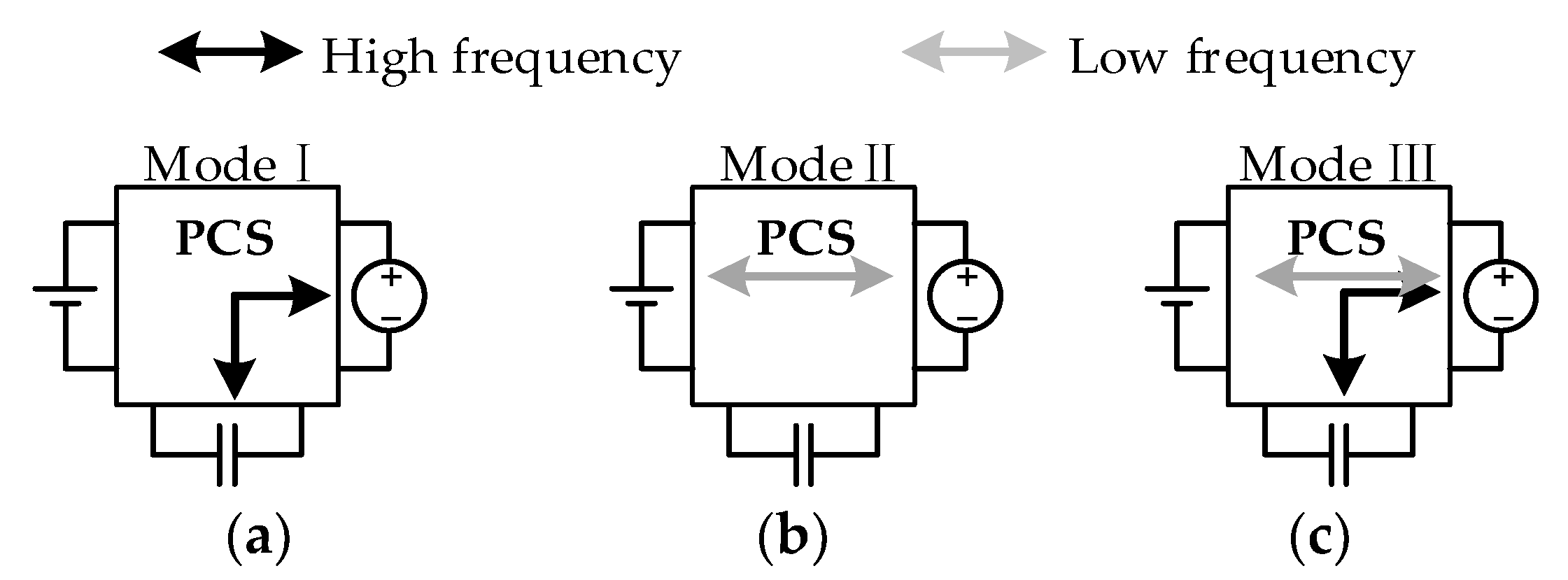



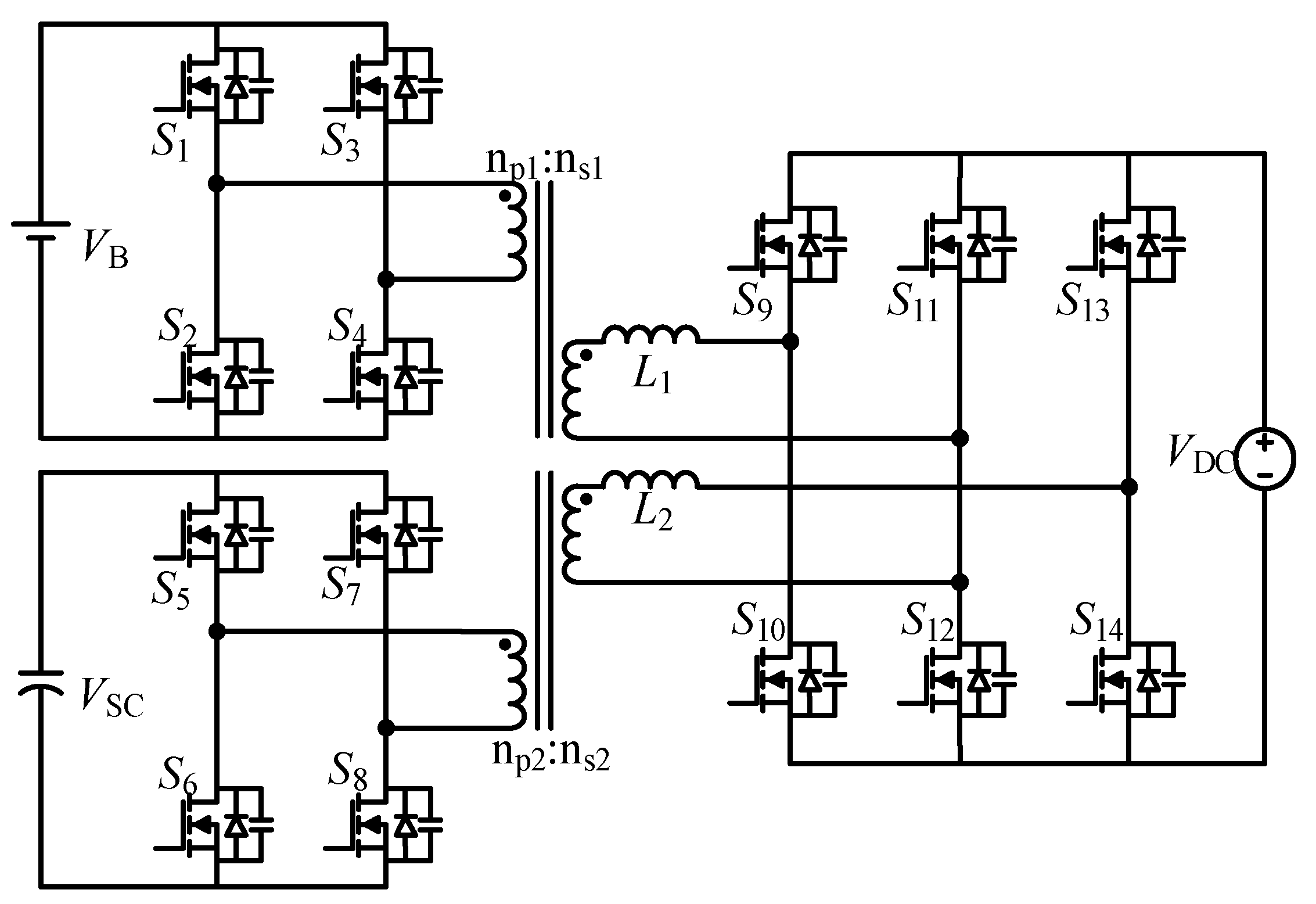




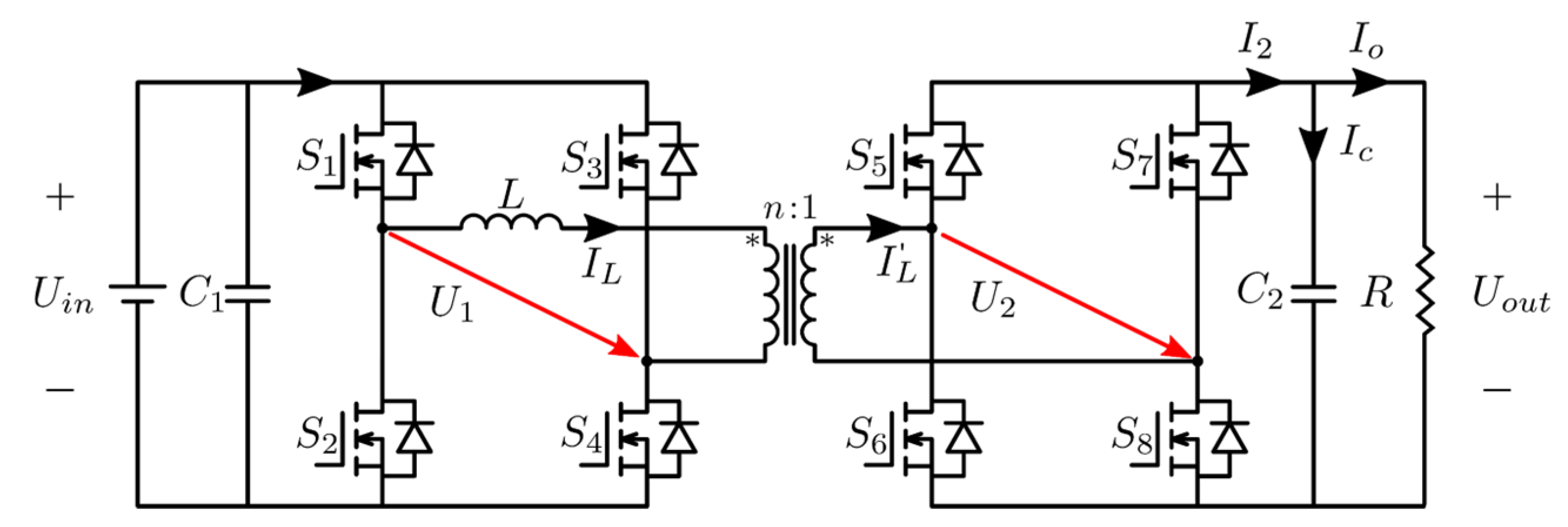



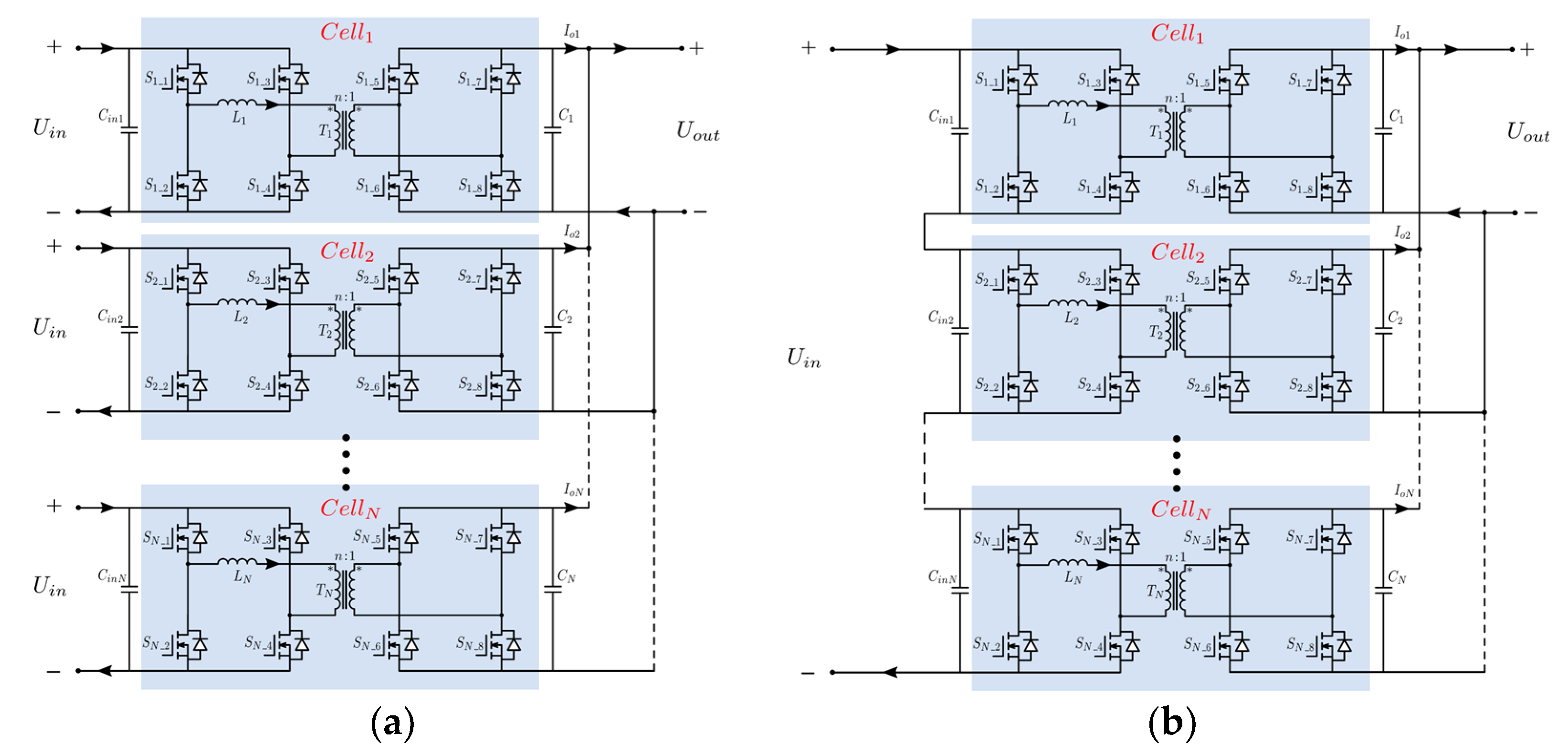
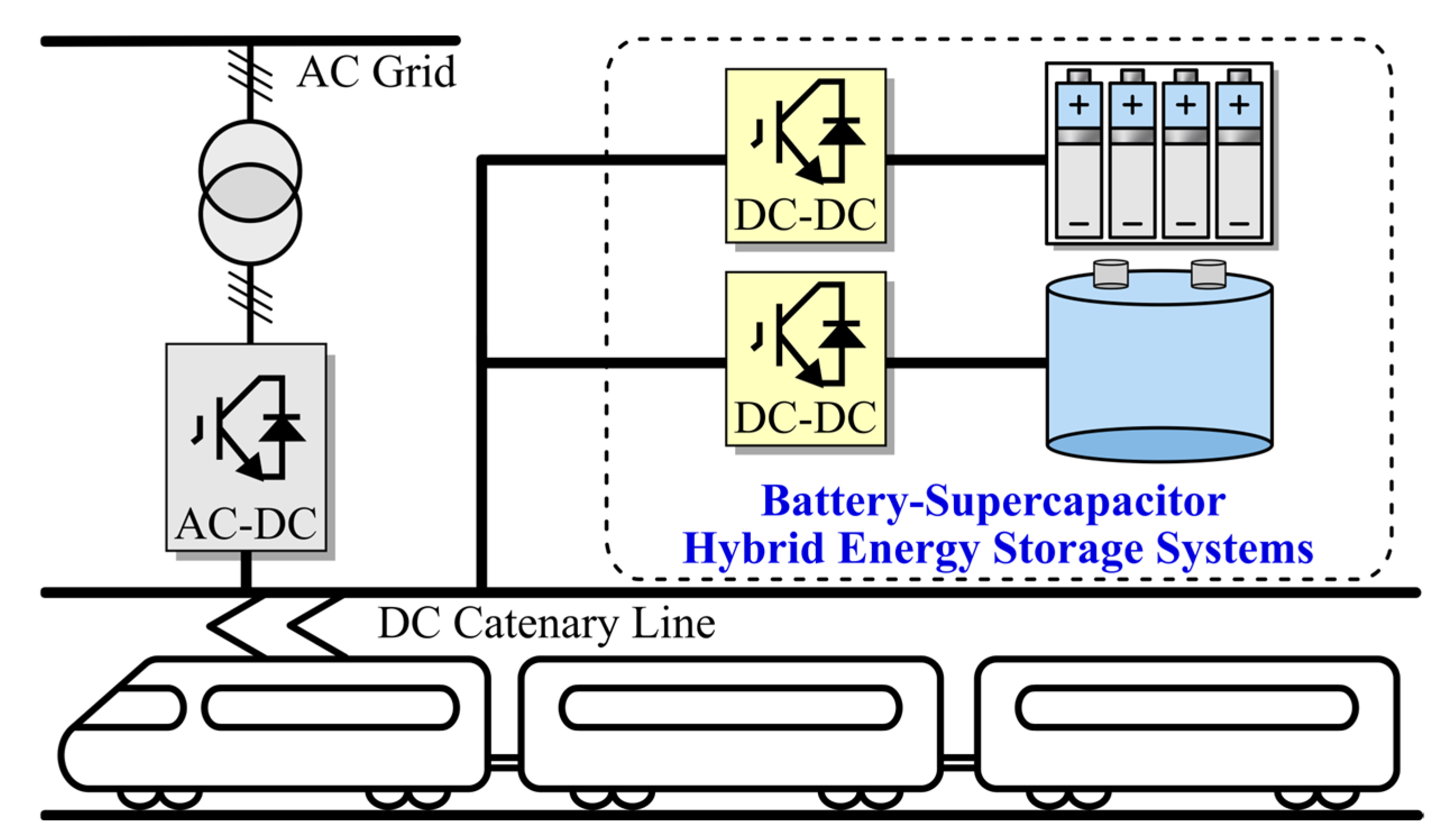
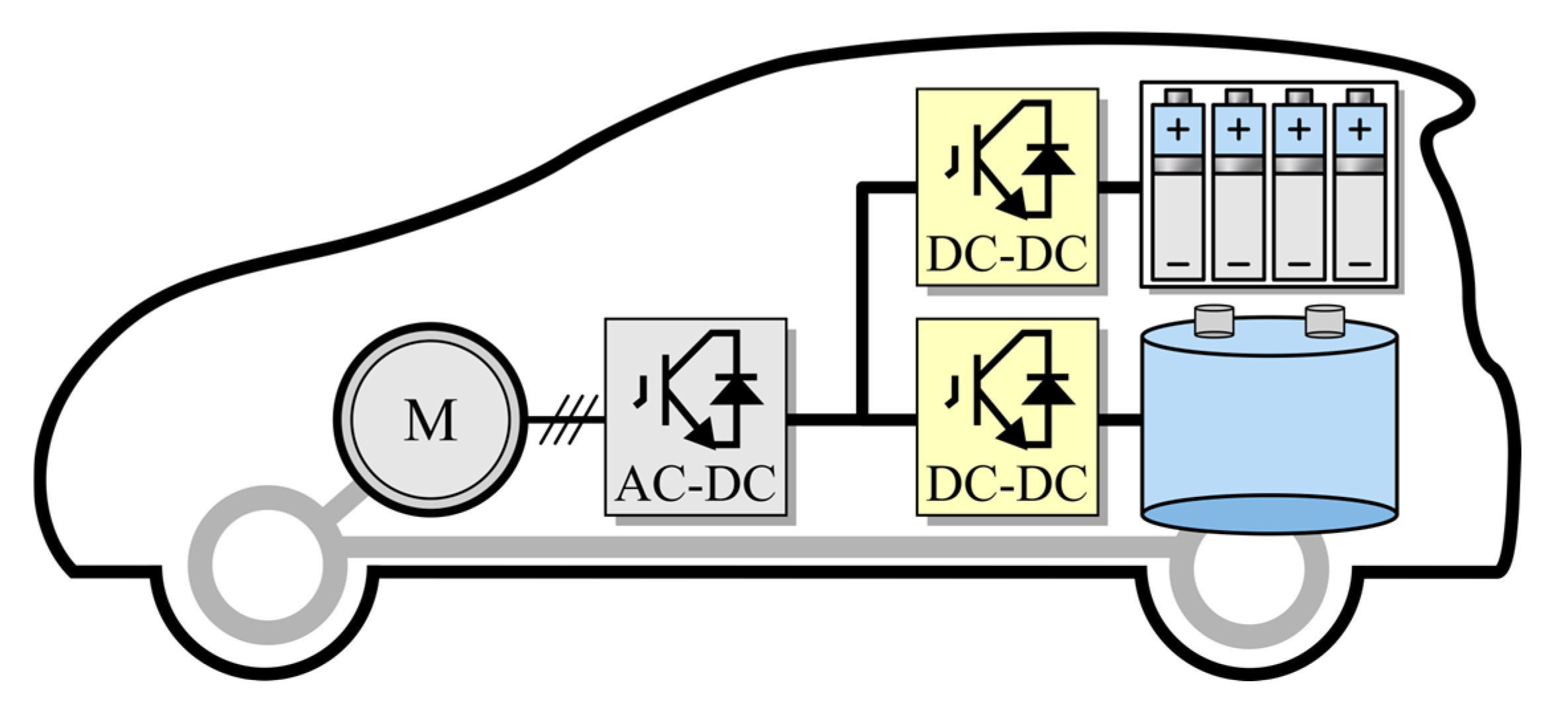

| Category Performance | Energy-Oriented Storage Devices | Power-Oriented Storage Devices | ||||
|---|---|---|---|---|---|---|
| Lead–Acid [20] | Lithium-Ion [21] | Sodium-Ion [22] | Redox Flow [23] | Supercapacitors [24] | Lithium-Ion Capacitors [25] | |
| Energy density /Wh·kg−1 | 30–50 | 120–250 | 150–240 | 15–25 | 0.2–20 | 6–11 |
| Power density /W·kg−1 | 75–300 | 150–315 | 150–230 | 80–150 | 100–10,000 | 1000–7000 |
| Lifetime/Year | 2–3 | 5–16 | 3–5 | 10–20 | 5–10 | -- |
| Cycle times/Time | 500–1000 | 1500–2500 | >2000 | >10,000 | >100,000 | >10,000 |
| High and low temperature property | inferior | inferior | superior | superior | superior | superior |
| Security | superior | inferior | superior | superior | superior | superior |
| Environmental impact | Lead contamination | No contamination | No contamination | No contamination | No contamination | No contamination |
| Charging time | 6–8 h | 30 min–8 h | 15 min–8 h | 30 min–8 h | ≤2 min | ≤2 min |
| Discharging time | 2–12 h | 30 min–8 h | 30 min–8 h | 30 min–8 h | 1–30 s | 1 s–30 min |
| Capital cost /USD/kWh | 75–105 | 180–375 | 390–495 | 524–750 | 287–1916 | ≈150 |
| Parameter | Battery Only | BS-HESS |
|---|---|---|
| Weight (kg) | 2300.92 | 1587.41 |
| Volume (L) | 1053.69 | 735.93 |
| Cost (%) | 144 | 100 |
| Max charge current (A) | 15.16 | 572 |
| Max discharge current (A) | 20.15 | 451 |
| Range (km) | 410,476 | 480,148 |
| Driving time (h) | 29,015 | 33,940 |
Publisher’s Note: MDPI stays neutral with regard to jurisdictional claims in published maps and institutional affiliations. |
© 2022 by the authors. Licensee MDPI, Basel, Switzerland. This article is an open access article distributed under the terms and conditions of the Creative Commons Attribution (CC BY) license (https://creativecommons.org/licenses/by/4.0/).
Share and Cite
Dong, Z.; Zhang, Z.; Li, Z.; Li, X.; Qin, J.; Liang, C.; Han, M.; Yin, Y.; Bai, J.; Wang, C.; et al. A Survey of Battery–Supercapacitor Hybrid Energy Storage Systems: Concept, Topology, Control and Application. Symmetry 2022, 14, 1085. https://doi.org/10.3390/sym14061085
Dong Z, Zhang Z, Li Z, Li X, Qin J, Liang C, Han M, Yin Y, Bai J, Wang C, et al. A Survey of Battery–Supercapacitor Hybrid Energy Storage Systems: Concept, Topology, Control and Application. Symmetry. 2022; 14(6):1085. https://doi.org/10.3390/sym14061085
Chicago/Turabian StyleDong, Zheng, Zhenbin Zhang, Zhen Li, Xuming Li, Jiawang Qin, Chenxuan Liang, Minghao Han, Yafei Yin, Jinzhe Bai, Chunyue Wang, and et al. 2022. "A Survey of Battery–Supercapacitor Hybrid Energy Storage Systems: Concept, Topology, Control and Application" Symmetry 14, no. 6: 1085. https://doi.org/10.3390/sym14061085
APA StyleDong, Z., Zhang, Z., Li, Z., Li, X., Qin, J., Liang, C., Han, M., Yin, Y., Bai, J., Wang, C., & Wang, R. (2022). A Survey of Battery–Supercapacitor Hybrid Energy Storage Systems: Concept, Topology, Control and Application. Symmetry, 14(6), 1085. https://doi.org/10.3390/sym14061085






